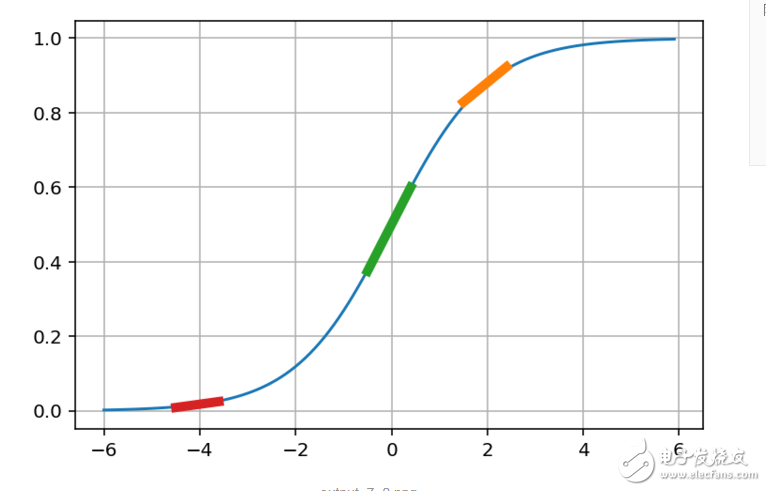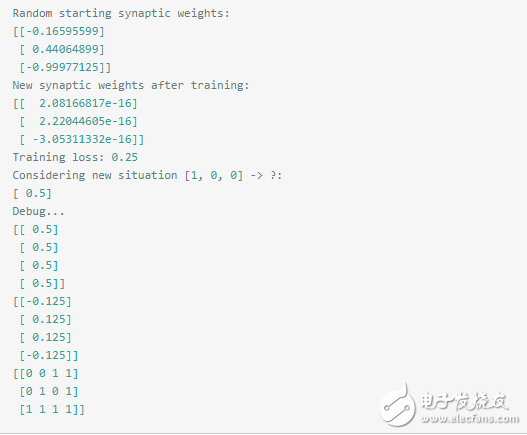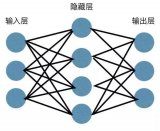? ? ? ? 簡單搭建自己的神經網絡
1. 模型闡述
假設我們有下面的一組數據
?
對于上面的表格,我們可以找出其中的一個規律是:
輸入的第一列和輸出相同
那對于輸入有3列,每列有0和1兩個值,那可能的排列有(2^3=8)種,但是此處只有4種,那么在有限的數據情況下,我們應該怎么預測其他結果呢?
看代碼:
%matplotlib inline
%config InlineBackend.figure_format = ‘retina’
from numpy import exp, array, random, dot
class NeuralNetwork():
def __init__(self):
# Seed the random number generator, so it generates the same numbers
# every time the program runs.
random.seed(1)
# We model a single neuron, with 3 input connections and 1 output connection.
# We assign random weights to a 3 x 1 matrix, with values in the range -1 to 1
# and mean 0.
self.synaptic_weights = 2 * random.random((3, 1)) - 1
self.sigmoid_derivative = self.__sigmoid_derivative
# The Sigmoid function, which describes an S shaped curve.
# We pass the weighted sum of the inputs through this function to
# normalise them between 0 and 1.
def __sigmoid(self, x):
return 1 / (1 + exp(-x))
# The derivative of the Sigmoid function.
# This is the gradient of the Sigmoid curve.
# It indicates how confident we are about the existing weight.
def __sigmoid_derivative(self, x):
return x * (1 - x)
# We train the neural network through a process of trial and error.
# Adjusting the synaptic weights each time.
def train(self, training_set_inputs, training_set_outputs, number_of_training_iterations):
for iteration in range(number_of_training_iterations):
# Pass the training set through our neural network (a single neuron)。
output = self.think(training_set_inputs)
# Calculate the error (The difference between the desired output
# and the predicted output)。
error = training_set_outputs - output
# Multiply the error by the input and again by the gradient of the Sigmoid curve.
# This means less confident weights are adjusted more.
# This means inputs, which are zero, do not cause changes to the weights.
adjustment = dot(training_set_inputs.T, error * self.__sigmoid_derivative(output))
# Adjust the weights.
self.synaptic_weights += adjustment
# The neural network thinks.
def think(self, inputs):
# Pass inputs through our neural network (our single neuron)。
return self.__sigmoid(dot(inputs, self.synaptic_weights))
#Intialise a single neuron neural network.
neural_network = NeuralNetwork()
print(“Random starting synaptic weights: ”)
print(neural_network.synaptic_weights)
# The training set. We have 4 examples, each consisting of 3 input values# and 1 output value.
training_set_inputs = array([[0, 0, 1], [1, 1, 1], [1, 0, 1], [0, 1, 1]])
training_set_outputs = array([[0, 1, 1, 0]]).T
# Train the neural network using a training set.# Do it 10,000 times and make small adjustments each time.
neural_network.train(training_set_inputs, training_set_outputs, 10000)
print(“New synaptic weights after training: ”)
print(neural_network.synaptic_weights)
# Test the neural network with a new situation.
print(“Considering new situation [1, 0, 0] -》 ?: ”)
print(neural_network.think(array([1, 0, 0])))
Random starting synaptic weights: [[-0.16595599]
[ 0.44064899]
[-0.99977125]]
New synaptic weights after training: [[ 9.67299303]
[-0.2078435 ]
[-4.62963669]]
Considering new situation [1, 0, 0] -》 ?: [ 0.99993704]
以上代碼來自:https://github.com/llSourcell/Make_a_neural_network
現在我們來分析下具體的過程:
第一個我們需要注意的是sigmoid function,其圖如下:
import matplotlib.pyplot as pltimport numpy as np
def sigmoid(x):
a = []
for item in x:
a.append(1/(1+np.exp(-item)))
return a
x = np.arange(-6., 6., 0.2)
sig = sigmoid(x)
plt.plot(x,sig)
plt.grid()
plt.show()
?
我們可以看到sigmoid函數將輸入轉換到了0-1之間的值,而sigmoid函數的導數是:
def __sigmoid_derivative(self, y):
return y * (1 - y)
其具體的含義看圖:
def sigmoid_derivative(x):
y = 1/(1+np.exp(-x))
return y * (1-y)
def derivative(point):
dx = np.arange(-0.5,0.5,0.1)
slope = sigmoid_derivative(point)
return [point+dx,slope * dx + 1/(1+np.exp(-point))]
x = np.arange(-6., 6., 0.1)
sig = sigmoid(x)
point1 = 2
slope1 = sigmoid_derivative(point1)
plt.plot(x,sig)
x1,y1 = derivative(point1)
plt.plot(x1,y1,linewidth=5)
x2,y2 = derivative(0)
plt.plot(x2,y2,linewidth=5)
x3,y3 = derivative(-4)
plt.plot(x3,y3,linewidth=5)
plt.grid()
plt.show()
?
現在我們來根據圖解釋下實際的含義:
1. 首先輸出是0到1之間的值,我們可以將其認為是一個可信度,0不可信,1完全可信
2. 當輸入是0的時候,輸出是0.5,什么意思呢?意思是輸出模棱兩可
基于以上兩點,我們來看下上面函數的中的一個計算過程:
adjustment = dot(training_set_inputs.T, error * self.__sigmoid_derivative(output))
這個調整值的含義我們就知道了,當輸出接近0和1時候,我們已經預測的挺準了,此時調整就基本接近于0了
而當輸出為0.5左右的時候,說明預測完全是瞎猜,我們就需要快速調整,因此此時的導數也是最大的,即上圖的綠色曲線,其斜度也是最大的
基于上面的一個討論,我們還可以有下面的一個結論:
1. 當輸入是1,輸出是0,我們需要不斷減小 weight 的值,這樣子輸出才會是很小,sigmoid輸出才會是0
2. 當輸入是1,輸出是1,我們需要不斷增大 weight 的值,這樣子輸出才會是很大,sigmoid輸出才會是1
這時候我們再來看下最初的數據,
?
我們可以斷定輸入1的weight值會變大,而輸入2,3的weight值會變小。
根據之前訓練出來的結果也支持了我們的推斷:

2. 擴展
我們來將上面的問題稍微復雜下,假設我們的輸入如下:
?
此處我們只是改變一個值,此時我們再次訓練呢?
我們觀察上面的數據,好像很難再像最初一樣直接觀察出 輸出1 == 輸出 的這種簡單的關系了,我們要稍微深入的觀察下了
· 首先輸入3都是1,看起來對輸出沒什么影響
· 接著觀察輸入1和輸入2,似乎只要兩者不同,輸出就是1
基于上面的觀察,我們似乎找不到像輸出1 == 輸出這種 one-to-one 的關系了,我們有什么辦法呢?
這個時候,就需要引入 hidden layer,如下表格:
?
此時我們得到中的中間輸入和最后輸出就還是原來的一個 輸出1 == 輸出 關系了。
上面介紹的這種方法就是深度學習的最簡單的形式
深度學習就是通過增加層次,不斷去放大輸入和輸出之間的關系,到最后,我們可以從復雜的初看起來毫不相干的數據中,找到一個能一眼就看出來的關系
此處我們還是用之前的網絡來訓練
?

此處我們訓練可以發現,此處的誤差基本就是0.25,然后預測基本不可信。0.5什么鬼!
由數據可以看到此處的weight都已經非常非常小了,然后斜率是0.5,
由上面打印出來的數據,已經達到平衡,adjustment都是0了,不會再次調整了。
由此可以看出,簡單的一層網絡已經不能再精準的預測了,只能增加復雜度了。
下面我們來加一層再來看下:
class TwoLayerNeuralNetwork(object):
def __init__(self, input_nodes, hidden_nodes, output_nodes, learning_rate):
# Set number of nodes in input, hidden and output layers.
self.input_nodes = input_nodes
self.hidden_nodes = hidden_nodes
self.output_nodes = output_nodes
np.random.seed(1)
# Initialize weights
self.weights_0_1 = np.random.normal(0.0, self.hidden_nodes**-0.5,
(self.input_nodes, self.hidden_nodes)) # n * 2
self.weights_1_2 = np.random.normal(0.0, self.output_nodes**-0.5,
(self.hidden_nodes, self.output_nodes)) # 2 * 1
self.lr = learning_rate
#### Set this to your implemented sigmoid function ####
# Activation function is the sigmoid function
self.activation_function = self.__sigmoid
def __sigmoid(self, x):
return 1 / (1 + np.exp(-x))
def __sigmoid_derivative(self, x):
return x * (1 - x)
def train(self, inputs_list, targets_list):
# Convert inputs list to 2d array
inputs = np.array(inputs_list,ndmin=2) # 1 * n
layer_0 = inputs
targets = np.array(targets_list,ndmin=2) # 1 * 1
#### Implement the forward pass here ####
### Forward pass ###
layer_1 = self.activation_function(layer_0.dot(self.weights_0_1)) # 1 * 2
layer_2 = self.activation_function(layer_1.dot(self.weights_1_2)) # 1 * 1
#### Implement the backward pass here ####
### Backward pass ###
# TODO: Output error
layer_2_error = targets - layer_2
layer_2_delta = layer_2_error * self.__sigmoid_derivative(layer_2)# y = x so f‘(h) = 1
layer_1_error = layer_2_delta.dot(self.weights_1_2.T)
layer_1_delta = layer_1_error * self.__sigmoid_derivative(layer_1)
# TODO: Update the weights
self.weights_1_2 += self.lr * layer_1.T.dot(layer_2_delta) # update hidden-to-output weights with gradient descent step
self.weights_0_1 += self.lr * layer_0.T.dot(layer_1_delta) # update input-to-hidden weights with gradient descent step
def run(self, inputs_list):
# Run a forward pass through the network
inputs = np.array(inputs_list,ndmin=2)
#### Implement the forward pass here ####
layer_1 = self.activation_function(inputs.dot(self.weights_0_1)) # 1 * 2
layer_2 = self.activation_function(layer_1.dot(self.weights_1_2)) # 1 * 1
return layer_2def MSE(y, Y):
return np.mean((y-Y)**2)
# import sys
training_set_inputs = array([[0, 0, 1], [0, 1, 1], [1, 0, 1], [1, 1, 1]])
training_set_outputs = array([[0, 1, 1, 0]]).T
### Set the hyperparameters here ###
epochs = 20000
learning_rate = 0.1
hidden_nodes = 4
output_nodes = 1
N_i = 3
network = TwoLayerNeuralNetwork(N_i, hidden_nodes, output_nodes, learning_rate)
losses = {’train‘:[]}for e in range(epochs):
# Go through a random batch of 128 records from the training data set
for record, target in zip(training_set_inputs,
training_set_outputs):# print(target)
network.train(record, target)
train_loss = MSE(network.run(training_set_inputs), training_set_outputs)
sys.stdout.write(“ Progress: ” + str(100 * e/float(epochs))[:4]
+ “% 。。。 Training loss: ” + str(train_loss)[:7])
losses[’train‘].append(train_loss)
print(“ ”)
print(“After train,layer_0_1: ”)
print(network.weights_0_1)
print(“After train,layer_1_2: ”)
print(network.weights_1_2)# Test the neural network with a new situation.
print(“Considering new situation [1, 0, 0] -》 ?: ”)
print(network.run(array([1, 0, 0])))
Progress: 99.9% 。。。 Training loss: 0.00078
After train,layer_0_1:
[[ 4.4375838 -3.87815184 1.74047905 -5.12726884]
[ 4.43114847 -3.87644617 1.71905492 -5.10688387]
[-6.80858063 0.76685389 1.89614363 1.61202043]]
After train,layer_1_2:
[[-9.21973137]
[-3.84985864]
[ 4.75257888]
[-6.36994226]]
Considering new situation [1, 0, 0] -》 ?:
[[ 0.00557239]]
layer_1=network.activation_function(training_set_inputs.dot(network.weights_0_1))
print(layer_1)
layer_2 = network.activation_function(layer_1.dot(network.weights_1_2))
print(layer_2)
[[ 2.20482250e-01 9.33639853e-01 6.30402293e-01 6.24775766e-02]
[ 1.77659862e-02 9.99702482e-01 8.64290928e-01 9.26611880e-01]
[ 6.94975743e-01 8.90040645e-02 8.51261229e-01 2.06917379e-04]
[ 1.27171786e-01 9.58904341e-01 9.55296949e-01 3.77322214e-02]]
[[ 0.02374213]
[ 0.97285992]
[ 0.97468116]
[ 0.02714965]]
最后總結:我們發現在擴展中,我們只是簡單的改變了兩個輸入值,此時再次用一層神經網絡已經難以預測出正確的數據了,此時我們只能通過將神經網絡變深,這個過程其實就是再去深度挖掘數據之間關系的過程,此時我們的2層神經網絡相比較1層就好多了。
 電子發燒友App
電子發燒友App





















評論